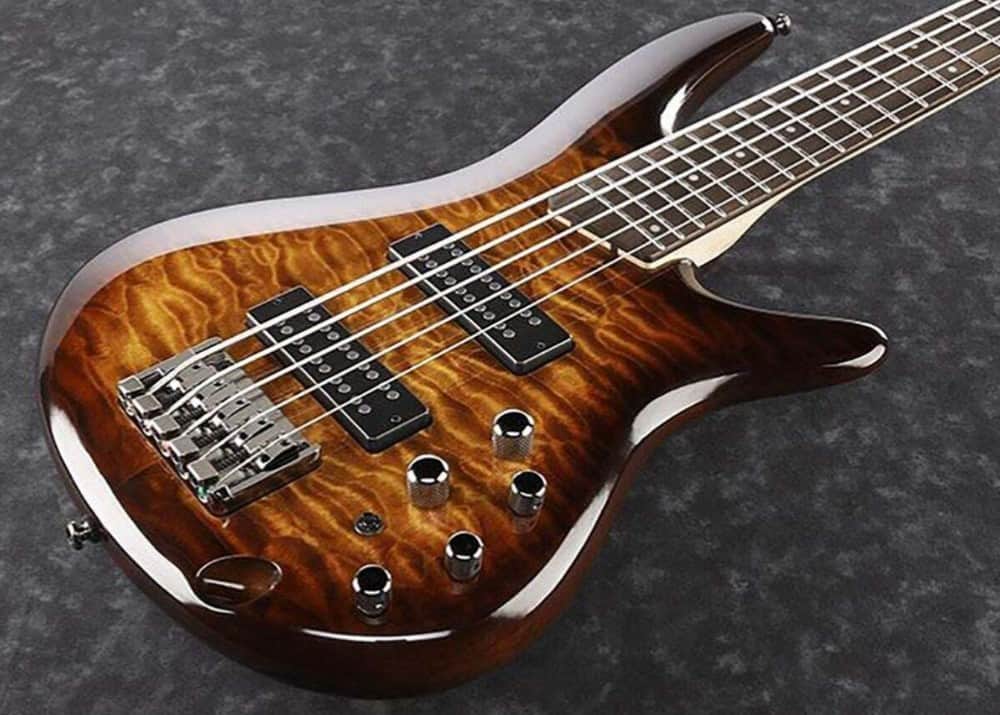Bass and drums are typically thought of as the backbone of a lot of music.
And oftentimes drummers and bassists are encouraged to “stay in the pocket” and not draw too much attention.
But sometimes the bass gets to shine and extended-range basses can help the sound stand out from the rest of the crowd. So what about the tuning?
Can you craft an even more signature sound by changing the tuning on a 5-string bass? Let’s see what some of the options are.
Some alternate tunings for 5-string bass are simple to try but others can require significant overhauls to the strings and instrument. So educate yourself and decide carefully. And if you play with others, talk to your bandmates to make sure you’re all on the same page (tuning) before you do anything drastic!
Although I have played around with some basses over the years I would never call myself a bassist and it’s been years since I’ve even touched one.
However, if you find yourself playing with someone who has a 5-string bass, I think it is useful to know what tunings are popular even if you are not the one playing bass.
And I’m sure the bassist will appreciate that you took the time to educate yourself a little as well. So here are some options to know about…
All you need to know about 5-string bass alternate tunings
There is a major difference in using alternate tunings between playing bass and guitar.
Guitars can really benefit from open tunings since a lot of chords are used whereas chords are pretty rare when playing bass.
And open guitar tunings are also used for slide guitar, which doesn’t apply to bass either.
So the most likely reason to use alternate tunings on bass is to extend your tonal range even more (usually lower).
Regarding 5-string basses, the lowest string is usually tuned to B so the standard tuning is B-E-A-D-G. This tuning for 5-string basses actually goes back to 1975.
But when I see extended-range instruments my mind usually associates them with heavy styles of music like hard rock, metal, and djent.
One of the most prominent examples of this would be the band Korn, which we will mention again later because they really popularized alternate tunings on extended-range instruments.
But 5-string basses have become pretty fashionable in many less aggressive styles of music as well and are common from manufacturers such as Fender rather than only companies like ESP or Schecter, which cater to metal and rock players.
In fact, Fender is credited with the first 5-string bass to be sold commercially, going all the way back to 1965 but with tenor tuning (E-A-D-G-C).
Gibson has also offered some 5-string basses in the past (EB and Thunderbird models) but I think that their current line-up only offers 4-strings.
But to return to the subject of alternate tunings, they can help you to differentiate your song from the crowd or give you two open strings with the same note an octave apart, great for funky bouncing bass lines.
So what are some of the 5-string bass tunings you should check out?
4 must-know 5-string bass tunings
1. Drop A
Starting with one of the simplest alternative tunings we have Drop A, meaning the lowest gauge string is lowered a full step from B to A.
So the full sequence of strings becomes A-E-A-D-G.
This is convenient because your top three strings will be A-E-A, forming an A5 chord if you choose to play them together, giving you power chords all the way up the fretboard.
It has a heavy sound that is great for rock and metal and since it is basically like playing Drop D tuning on a guitar or 4-string bass it should feel familiar to many players.
2. A Standard
The next tuning to tackle is A Standard, or tuned down one whole step.
Of course, you could tune down ½ step or 1 ½, 2, etc., but we will examine this one since it has been in popular use.
The notes that the strings are tuned to are thus A-D-G-C-F.
This will work well with similarly tuned 7-string guitars or even six-string guitars tuned down a full step.
And this is the aforementioned 5-string bass tuning that was used by Korn to achieve their signature sound. Even if you don’t enjoy their style of music, if you have heard it then I’m sure you know exactly what this tuning sounds like.
So if you play a lot of heavy music this is one to check out for sure and you can basically play “normally” since the string intervals remain the same as B standard.
3. Drop C
Another tuning that you can achieve with a 5-string bass is Drop C.
This is done by tuning your strings to C-G-C-F-A.
This one is a bit strange because you actually have to tune up from standard tuning if you are using a 5-string bass.
It will still be lower and heavier than a 4-string bass in normal tuning but why not just use a bass with 4 strings and tune down to achieve this tuning?
Drop C has been used in quite a few rock and metal songs but to be honest I think if you have a 5-string bass then I would save this one for a rainy day when you’re really bored.
4. Tenor Tuning
Now comes another curve ball with a tuning that is sometimes referred to as Tenor Tuning.
This tuning uses the notes E-A-D-G-C.
Obviously, you are adding a lighter gauge string instead of a heavier gauge one so you are extending your range higher with this one.
I believe this was the original setup for 5-string basses (like the Fender Bass V) before bands began to compete to see who could play the lowest and heaviest.
This may not be as popular as the B standard but it is useful for jazz and people who play bass solos.
This is also the one that I find the most interesting and could be used to create your own unique 5-string tunings like C-G-C-G-C.
Before we move on, you can check out this link to a short video that demonstrates some of the sounds you can get with this tuning:
Should you set up your bass every time you change its tuning?
While alternate tunings may seem cool on paper (or watching someone else use them), there can be a lot of work to be done behind the scenes.
As someone who mainly plays guitar, I know what drastic tuning changes can do to the sound quality of a stringed instrument.
So… if you want to try out Drop A or A Standard tuning you should be able to do it without too much trouble.
But that doesn’t necessarily mean you can perform or record like that.
You will need to find the correct strings for the best tension, adjust the truss rod accordingly, and maybe even tweak the action for the best results.
I highly recommend getting a professional setup (if you can’t do it yourself) if you are going to permanently change your tuning.
This means that if you want to use multiple tunings on a regular basis then it would be best to have a separate bass for each tuning.
Hey, who said innovation is cheap?
A brief guide to alternate tunings and string gauges
Your basic rules apply to most of these tunings, with thicker strings recommended for tuning down and lighter strings for tuning up.
Bass strings ranging from .045-.050 to .125-.135 are considered medium gauge but if you want to use a lot of Drop A or A Standard tuning then there are sets specifically made for down-tuning such as DR brand’s DDT5-55 (.055-.135).
For the ‘tuning up’ required for Drop C, I would look for a lighter gauge set or ask a guitar tech for recommendations.
This brings us to the problem child: E-A-D-G-C tenor tuning.
You could get a set of strings for a 6-string bass and discard the B string, but you can also look for specialized 5-string sets from brands like Fodera with a high-C string included (.028 – .100) or simply buy a single string like a .030-gauge GHS Boomer for under $6.
There are plenty of options, but again, I think that getting a professional setup and asking a guitar tech for recommendations the first time you permanently switch to an alternative tuning will be worth it in the long run.

Hello there, my name is Ramiro and I’ve been playing guitar for almost 20 years. I’m obsessed with everything gear-related and I thought it might be worth sharing it. From guitars, pedals, amps, and synths to studio gear and production tips, I hope you find what I post here useful, and I’ll try my best to keep it entertaining also.





